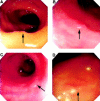Flat adenomas exist in asymptomatic people: important implications for colorectal cancer screening programmes
- PMID: 10189849
- PMCID: PMC1727201
- DOI: 10.1136/gut.43.2.229
Flat adenomas exist in asymptomatic people: important implications for colorectal cancer screening programmes
Abstract
Background: Flat adenomas are non-exophytic with a flat top or central depression and histologically the depth of dysplastic tissue is never more than twice the mucosal thickness. Flat adenomas frequently contain severely dysplastic tissue, and may progress rapidly through the adenoma-carcinoma sequence. Flat lesions have never been described in a British asymptomatic population.
Aims: To determine whether flat adenomas exist in an asymptomatic population participating in a large randomised controlled trial of flexible sigmoidoscopy screening.
Patients: A total of 3000 subjects (aged 55-64 years) underwent screening by flexible sigmoidoscopy.
Methods: All polyps were removed and sent for histology. The number of polyps with endoscopic and histological features of flat adenomas was recorded.
Results: Three subjects had a total of four flat lesions--that is, one per 1000 people screened. Three contained severely dysplastic tissue, one a focus of adenocarcinoma. Three of the four lesions were less than 5 mm in size and the fourth was 15 mm in diameter.
Conclusions: Flat lesions with severe dysplasia exist in the asymptomatic population. This has major implications for gastroenterologists who should be trained to identify them. Their existence is of importance to molecular biologists and epidemiologists investigating the aetiology of colorectal cancer.
Figures
References
Publication types
MeSH terms
LinkOut - more resources
Full Text Sources
Medical


